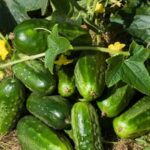Are you looking to add a new and versatile fruit to your vegetable garden? Limes are a fantastic addition to any vegetable garden, offering a variety of benefits and uses. From adding a pop of flavor to your dishes to serving as natural pest control, limes can enhance the overall health and productivity of your vegetable garden.
When it comes to incorporating limes into your vegetable garden, choosing the right varieties is key. With so many different types of limes available, it’s important to select the ones that best suit your specific growing conditions and culinary needs. Understanding the ideal growing conditions for limes in vegetable gardens will also ensure that your lime trees thrive and produce quality fruit.
The process of planting and caring for lime trees in your vegetable garden requires some knowledge and attention to detail. From proper spacing and pruning techniques to regular watering and fertilization, taking care of your lime trees is essential for a bountiful harvest. Additionally, knowing how to incorporate limes into your vegetable garden design can not only enhance the visual appeal but also improve the overall health of the plants.
Choosing the Right Varieties of Limes for Your Garden
When it comes to growing limes in your vegetable garden, choosing the right varieties is crucial for success. There are several types of lime trees that are well-suited for home gardens, each with its own unique characteristics and requirements.
One popular variety is the Bearss (Tahitian) lime, known for its juicy and seedless fruit, perfect for both culinary and beverage use. Another common option is the Kaffir lime, which is prized for its aromatic leaves that add a distinctive flavor to many Asian dishes.
Key Factors to Consider When Choosing Lime Varieties:
1. Climate Suitability: Different lime varieties have specific climate requirements, so it’s essential to select one that thrives in your local conditions.
2. Fruit Usage: Consider whether you primarily want limes for culinary purposes or if you also plan to use the leaves or zest in cooking.
3. Tree Size: Some lime trees are compact and ideal for small gardens or containers, while others can reach significant heights and require more space.
For those interested in growing organic produce, there are also options such as Mexican thornless limes, which are known for their resistance to pests and diseases. These varieties can be an excellent choice for environmentally-friendly gardening practices within vegetable gardens that incorporate natural pest control methods.
| Lime Variety | Main Characteristics |
|---|---|
| Bearss (Tahitian) Lime | Juicy, seedless fruit; Suitable for beverages and cooking |
| Kaffir Lime | Aromatic leaves used in Asian cuisine; Unique bumpy fruit |
| Mexican Thornless Lime | Resistant to pests and diseases; Ideal for organic gardening practices |
By carefully considering the specific traits of different lime varieties, gardeners can choose the right one to enhance their vegetable gardens while enjoying a bountiful harvest of fresh limes throughout the growing season.
Understanding the Ideal Growing Conditions for Limes in Vegetable Gardens
When it comes to growing limes in your vegetable garden, understanding the ideal growing conditions is crucial for a successful harvest. Limes thrive in warm and sunny climates, making them suitable for vegetable gardens in regions with mild winters and hot summers. When choosing a spot for your lime tree, make sure it receives at least 6-8 hours of full sunlight daily.
Soil Requirements
Lime trees prefer well-draining soil with a slightly acidic pH level between 6.0 and 7.0. Before planting, amend the soil with organic matter such as compost or well-rotted manure to improve its fertility and drainage. Avoid planting limes in waterlogged or clayey soils, as they are susceptible to root rot under these conditions.
Watering and Humidity
Lime trees have moderate water needs and require regular watering during the growing season. However, ensure that the soil is allowed to dry out slightly between waterings to prevent waterlogged conditions. Additionally, limes thrive in humid environments, but good air circulation is essential to prevent fungal diseases such as powdery mildew.
Temperature and Frost Protection
Lime trees are sensitive to cold temperatures and can be damaged by frost. It’s crucial to plant them in a location protected from harsh winds and frost pockets, especially during the winter months. In cooler climates, consider growing limes in containers that can be moved indoors during the winter or provide frost protection with row covers or blankets.
By understanding and providing the ideal growing conditions for limes in your vegetable garden, you can ensure a bountiful harvest of this citrus fruit for years to come. With proper care and attention to their specific needs, lime trees can thrive and become a valuable addition to your homegrown vegetable garden.
The Process of Planting and Caring for Lime Trees in Your Vegetable Garden
Lime trees can be a wonderful addition to your vegetable garden, providing not only delicious fruit but also aesthetic appeal and potential natural pest control. Here are some key steps and tips for planting and caring for lime trees in your vegetable garden:
1. Selecting the Right Tree: When choosing a lime tree for your vegetable garden, consider factors such as the climate in your area, the available space for the tree to grow, and the variety of lime you prefer. Some popular varieties of limes for home gardens include Bearss limes, Key limes, and Kaffir limes.
2. Planting Your Lime Tree: Choose a location in your vegetable garden that receives plenty of sunlight and has well-drained soil. Dig a hole twice as wide as the root ball of your tree and set it into the hole at the same level it was growing in its nursery container. Fill in the hole with soil and water thoroughly.
3. Caring for Your Lime Tree: Ensure that your lime tree receives adequate water, especially during dry periods, but be cautious not to overwater as this can lead to root rot. Consider mulching around the base of the tree to help retain moisture and suppress weed growth. Prune your lime tree as needed to remove dead or damaged branches and promote healthy growth.
By following these steps and providing proper care, your lime tree can thrive in your vegetable garden and provide you with an abundance of fresh limes for years to come.
Additionally, incorporating a lime tree into your vegetable garden can also benefit other plants by providing natural pest control. The strong scent of citrus from the lime tree can deter pests such as aphids, ants, and even cats from damaging your vegetables. Consider planting companion plants near your lime tree that can further complement its pest-repelling properties, creating a more harmonious environment for all of your plants.
Whether you are looking to add zest to culinary creations or simply enjoy homegrown fruits straight from your garden, growing limes alongside your vegetables can be a rewarding endeavor that adds both beauty and utility to your gardening space.
How to Incorporate Limes Into Your Vegetable Garden Design
Incorporating limes into your vegetable garden design can not only add a beautiful and aromatic element to your garden but can also provide numerous benefits for your other vegetables. Limes are not only a delicious addition to many dishes, but they can also act as natural pest deterrents and even provide natural fertilization for your vegetable plants.
Companion Planting
One way to incorporate limes into your vegetable garden design is through companion planting. Consider planting lime trees alongside other vegetables that benefit from their presence. For example, limes can help deter pests such as aphids, caterpillars, and even ants, making them an ideal companion for plants like tomatoes, peppers, and cucumbers. Additionally, the fragrance of the lime tree can help mask the scent of other vegetables, making it harder for pests to locate them.
Strategic Placement
When designing your vegetable garden layout, consider strategically placing lime trees in areas where they can provide shade or wind protection for more delicate vegetables. Limes also thrive in well-drained soil with plenty of sunlight, so be sure to plant them in an area that meets these growing conditions.
Use as an Ornamental Element
Incorporating limes into your vegetable garden design doesn’t have to be solely functional-consider using them as an ornamental element as well. The vibrant green color of limes adds visual interest to the garden and can complement the colors of other vegetables. You can plant lime trees in decorative pots or include them in a citrus-themed section of your garden for added aesthetic appeal.
By carefully considering how to incorporate limes into your vegetable garden design, you not only enhance the visual appeal of the space but also reap the benefits of natural pest control and fertilization for your other vegetables. With some thoughtful planning and strategic placement, limes can become a valuable and attractive addition to any vegetable garden.
Using Limes for Pest Control and Natural Fertilization in Vegetable Gardens
Limes are not only a delicious addition to your vegetable garden, but they also have multiple benefits when it comes to pest control and natural fertilization. Here are some ways you can use limes to keep your vegetable garden healthy and thriving:
- Pest Control: Limes contain natural oils that act as a repellent for common garden pests such as aphids, snails, and slugs. You can create a simple homemade pest control spray by mixing lime juice with water and a few drops of dish soap. This solution can be sprayed directly onto the leaves of your vegetables to deter pests without harming the plants.
- Soil Fertilization: Lime is an excellent source of calcium and other essential nutrients that are beneficial for the overall health of your soil. The application of lime to your vegetable garden can help neutralize acidic soil, improve soil structure, and provide a boost of nutrients for plant growth. Additionally, lime helps to enhance the effectiveness of other fertilizers by promoting better nutrient absorption by the plants.
- Composting: Limes can also be used to enhance the quality of compost in your vegetable garden. Adding lime rinds or leftover pulp from juiced limes into your compost pile can accelerate the decomposition process and help create nutrient-rich compost that will benefit your plants.
By incorporating limes into your pest control and fertilization practices, you can ensure that your vegetable garden remains healthy and productive throughout the growing season.
Overall, utilizing limes in your vegetable garden not only adds a refreshing twist to your homegrown produce but also serves as a natural way to protect and nourish your plants.
Harvesting and Preserving Limes From Your Vegetable Garden
Once your lime trees have matured and are producing fruit, it’s important to harvest the limes at the right time to ensure optimal flavor. Limes are typically ready to be harvested when they have reached their full size and have turned a vibrant green color. However, for certain varieties, such as key limes, waiting until they turn slightly yellow can result in a sweeter flavor.
When harvesting limes from your vegetable garden, it’s best to use pruning shears or scissors to carefully cut the fruit from the tree. Avoid pulling or twisting the limes off the branches, as this can damage the tree. After harvesting, it’s important to properly store your limes to preserve their freshness. Limes can be stored at room temperature for about a week, or in the refrigerator for up to three weeks.
To preserve an abundant lime harvest from your vegetable garden, consider freezing or canning the excess fruit. Limes can be frozen whole or in slices, and used later for cooking and making drinks. Additionally, you can make homemade lime juice and zest to freeze for future use in recipes.
| Lime Storage Method | Storage Duration |
|---|---|
| Room Temperature | 1 week |
| Refrigerator | Up to 3 weeks |
| Freezing Whole Limes | Up to 6 months |
| Canning Lime Juice | Lime juice can last for up to a year when canned |
Creative Recipes and Uses for Limes From Your Homegrown Vegetable Garden
In conclusion, growing limes in your vegetable garden can be a rewarding and beneficial experience. Not only do limes add a refreshing and tangy flavor to your dishes, but they also have numerous benefits for the overall health of your garden. By choosing the right varieties of limes and understanding their ideal growing conditions, you can ensure a successful harvest year after year.
Incorporating limes into your vegetable garden design can also add a pop of color and unique texture to your landscape. Whether it’s using lime trees as a focal point or incorporating them into your garden borders, limes can enhance the aesthetic appeal of your garden while also providing delicious fruit for culinary use.
Furthermore, utilizing limes for pest control and natural fertilization in your vegetable gardens can help create a more sustainable and eco-friendly growing environment. Limes can act as a natural repellent for certain pests and their peels can be used as a compost additive, enriching the soil with essential nutrients.
Ultimately, harvesting and preserving limes from your homegrown vegetable garden opens up endless possibilities for creative recipes and uses. From zesty dressings and marinades to refreshing beverages and desserts, homegrown limes can elevate the flavors of your culinary creations while promoting the health and vitality of your vegetable garden. So why not consider adding some lime trees to your vegetable garden this season?

If you’re looking to get into vegetable gardening, or are just looking for some tips on how to make your current garden better, then you’ve come to the right place! My name is Ethel and I have been gardening for years. In this blog, I’m going to share with you some of my best tips on how to create a successful vegetable garden.





